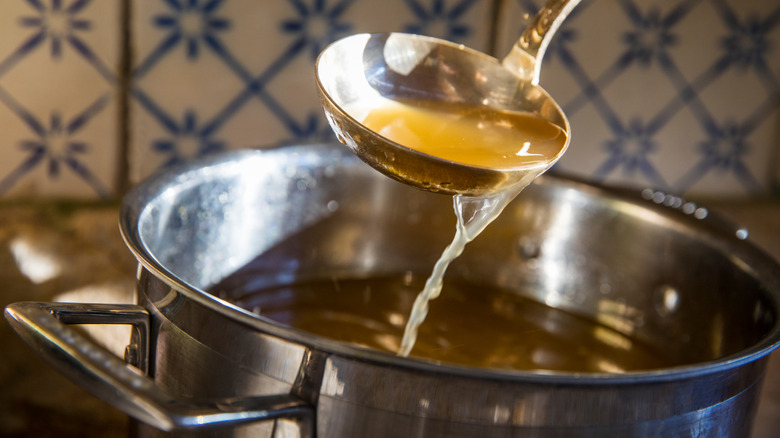Can You Substitute Broth For Stock When Making Soup?
Whether it's cold season or you're simply craving a warm bowl of comfort, broth and stock are always go-to ingredients. From gravies to stews, these liquids play a starring role in many dishes that not only warm you up but also fill your bellies, especially when the chill sets in. But can they be swapped out for one another when you're making your favorite warming soup recipes? The reality is, the differences between stock and broth are pretty subtle — and sometimes, they're more about personal preference than anything else. While some recipes give you a choice, others may be a bit more specific. But hey, that's where creative liberty is encouraged.
The main distinction between stock and broth lies in the preparation. Darker-colored stock is typically created by simmering roasted bones like chicken or beef, while lighter broth is created from the skin and meat of the animal. While broths can sometimes include bones, it's not always a must. Stock is usually cooked for much longer than broth, too. And seasonings also help differentiate the two. Broth typically is seasoned with salt for a mild addition to its flavor, while stock isn't. This sometimes allows the latter to serve as a more versatile and customizable base for recipes.
While stock and broth have subtle variations, either can make a delicious addition to your soups, sauces, and hearty dishes such as homemade buttermilk-braised pork shoulder. But if you're substituting broth for stock when making soup, you may have to make some adjustments to get the taste and texture you're after.
Balance the flavors when swapping stock and broth
It's important to know how to adjust the recipe if you decide to swap between broth and stock when making soup and other recipes. If you're using stock instead of broth, a sprinkle of seasoning like salt is all it takes to balance it out and add extra depth of flavor. On the flip side, if you're using broth instead of stock, you may need to add some water to dilute the saltiness of the broth. In terms of texture and consistency, stock can also be thicker, but if you add a little water it can be used more like a broth.
There's a whole world of stocks and broths that exists beyond chicken and beef, and some are more full-flavored than others. Brown stock is rich, robust, and generally used in sauces; white stock, where the bones haven't been roasted, is lighter; and fumets refer to fish or vegetable stocks. Vegetable stock (which is pretty much the same as vegetable broth aside from the seasoning) is simply veggies, water, and a few aromatic herbs simmered for about an hour. Think about which would work best in your particular soup in terms of flavor and richness.
After you've made your tasty broths or stocks, storing them is a breeze, though they are slightly different as well. Broth doesn't create a gelatinous consistency when refrigerated, but stock does since it's made with collagen-containing bones. You can keep a stock bag in the freezer to use in later meals, and broth also freezes well. And whether you've used broth or stock in your favorite big-batch recipe, you can always turn leftover soup into pasta sauce to create a whole new meal.

